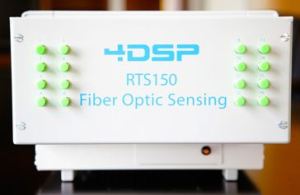Engineers are relying more and more on fiber reinforced composite materials in modern aerospace, automotive, and civil structures. Because of the inhomogeneous, layered, and directional nature of these materials, the modes by which they fail can be ex- tremely complex and difficult to model, locate, quantify, and track.
 RTS150
RTS150
4DSP’s distributed strain sensing technology allows engineers to detect and pinpoint various types of composite failure – all while avoiding vehicle downtime and other timely nondestructive meth- ods. A 6 inch long cantilevered fiberglass-epoxy composite beam with a central delamination region has been used to demonstrate this capability.
4DSP’s interrogation instrument, the RTS150, outputs con- tinuous strain profiles along hair-like and virtually weightless fiber optic cables. One of these fibers has been installed across the en- tire span of the composite coupon to sense the tensile and com- pressive bending strains along the axial direction. One end of the beam was fixed and the other left free, creating a cantilever setup. In this configuration, an undamaged, elastic beam subjected to a tip load will exhibit a linear strain profile. The highest strains will be at the fixed end, and they will decrease to zero at the free end. The two plots to the left show the unloaded and loaded strain states along the beam’s length. The beam begins with zero strains, as shown by the horizontal line in the first figure. The second figure shows the strain profile with an applied tip load. Normally, the strains would follow the linear dashed line, indicating that there is no damage to the structural component. However, the delaminated region disrupts this profile and yields a localized region of signifi- cantly larger deformation. 4DSP’s RTS150 can pick up on this unique strain profile, informing engineers of the location, mode, severity,and propagation of composite failure.